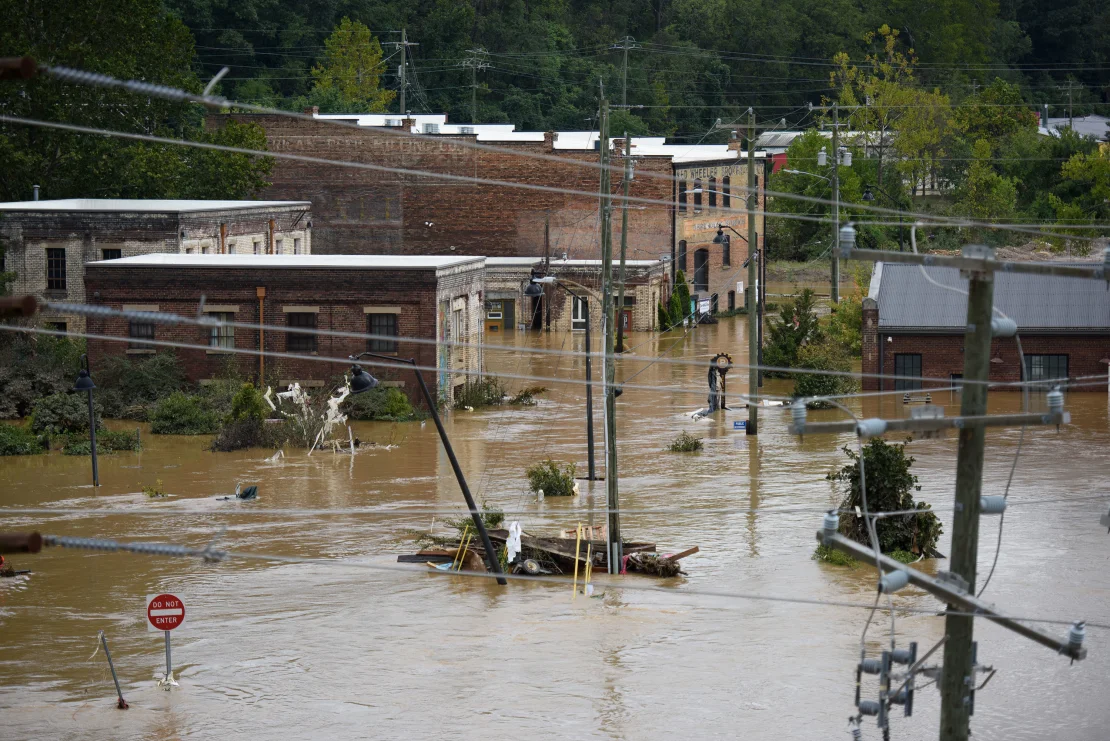One storm, 95 dead and a 500-mile path of destruction. Now comes the hard work of recovering from Helene

Short on supplies, short on power and short on patience, the people who saw the power of a massive storm upend their lives have emerged to a new week, facing the daunting challenge of rebuilding. Some of the roads and bridges they need to do the job aren’t there anymore. Electricity could be a week away or longer. Emergency services are stretched. And neighbors, some of whose own homes are gone, are helping neighbors.
At least 95 people have died across six states and officials believe there could be more. So far, state and county officials said 36 people died in North Carolina, 25 in South Carolina, 17 in Georgia, 11 in Florida, four in Tennessee and two in Virginia. Many more remain missing, perhaps unable to leave their location or unable to contact family where communications infrastructure is in shreds.
Hundreds of roads remain closed, especially in the Carolinas, hampering the delivery of badly-needed supplies. And more than 2 million customers remain without power, according to PowerOutage.us. Power companies are dealing with damaged and blocked roads as they work to restore power to homes and businesses.
President Joe Biden will visit some of the affected communities later this week, “as soon as it will not disrupt emergency response operations,” the White House said Sunday evening. He will speak Monday morning at the White House about federal efforts underway to speed resources to where they are needed. The president approved disaster relief and has been in contact with the governors where the damage was most severe.
‘My heart is broken for our people here’
Amid cleanup efforts, a Buncombe County resident told CNN she has no power, running water or cell phone reception.
Clutching firewood in her hands, Meredith Keisler, a school nurse, said: “We’re collecting wood because we have a grill to make fire, to cook food,” she said.
While Keisler says she considers herself lucky with resources at her home, she plans to work at a shelter to help others.
“It’s incredible — the destruction. It’s really sad,” she noted when asked about her surroundings.
About 20 miles east of Asheville, Krista Cortright said her boyfriend’s grandmother had no way of getting out of Black Mountain due to flooding. Cortright told CNN the couple had to get to her since she had limited supplies and she is diabetic.
It typically takes the couple 25 minutes to travel from Marion to the grandmother’s house. On Sunday, due to road closures, it took them 2.5 hours.
“Things are even more devastating in person,” Cortright said. “(Western North Carolina) is going to take a very long time to recover, but I am so grateful that we are here and doing OK. My heart is broken for our people here.”
Before power can be restored, infrastructure needs a fix
Michael Callahan, president of Duke Energy’s utility operations in South Carolina, said infrastructure repairs need to precede power restoration efforts.
“The poles and wires that make up our transmission system have experienced unprecedented damage.” Callahan said at a news conference.
Still, the utility hoped to have most of its customers in the state back up by Friday, he said.
“And with the exception of areas that are inaccessible or unable to take service, that doesn’t mean your power will be out until Friday,” he clarified.
As of Sunday night, about 760,000 homes and businesses were without electricity in South Carolina, according to PowerOutage.us.
In Georgia, Florida, North Carolina and Virginia, more than 1.2 million customers were without power.
With communications down, hundreds of people still unaccounted for
Officials in Buncombe County, North Carolina – where at least 30 people have died – have received about 600 missing persons reports through an online form, County Manager Avril Pinder said Sunday.
Former FEMA administrator Craig Fugate encouraged people not to lose hope.
Communications being out and loved ones being unreachable “doesn’t necessarily mean the worst has happened,” he told CNN on Sunday, adding people will be reunited once cell phone reception and internet are restored.
The state’s telecommunications partners activated disaster roaming on all networks, meaning “any phone on any carrier can access any network to place calls,” state Emergency Management Director William Ray said.
“Although we know we have lost lives, we generally see more people that are missing or unaccounted for because of communication,” Fugate said.
The governor addressed earlier reports of 1,000 people having gone unaccounted for.
“There have been about 1,000 calls. We don’t know the results of all of those calls,” he said, adding most people are likely safe but do not yet have phone or internet service.
He added, however, the official death toll could rise.
“We also know that there are going to be a lot of fatalities from this tragedy,” Cooper said. “We don’t know how many because search and rescue operations are still going on.”
President Biden to visit after promising help from Washington
The President will visit impacted communities from the storm later this week, the White House said Sunday evening.
On Sunday, Biden spoke with Georgia Gov. Brian Kemp and North Carolina Gov. Roy Cooper as well as other officials across North Carolina, Tennessee, Florida and South Carolina.
He was briefed Sunday by Federal Emergency Management Agency Administrator Deanne Criswell and Homeland Security Adviser Liz Sherwood-Randall on recovery efforts from Hurricane Helene. Criswell visited Georgia on Sunday and is set to go to North Carolina on Monday.
The White House said Biden monitored recovery efforts while in Rehoboth Beach, Delaware, this weekend, after approving pre-landfall emergency declarations for Florida, Georgia, North Carolina, and Alabama. He subsequently issued declarations for Tennessee and Virginia.
Former President Donald Trump on Sunday sent his condolences to those affected by Helene, which was the strongest hurricane on record to slam into Florida’s Big Bend region.
“Before we begin, I’d like to send my love and prayers to the families of those who have died – a lot of death — and all of those who are displaced and suffering in the wake of the hurricane’s destruction in the South, especially in Florida, Georgia, Alabama, Tennessee, and in particular, western North Carolina took a tremendous hit,” Trump said at a campaign rally in Erie, Pennsylvania.
“It’s been absolutely devastated, and God be with you all. It’s been a rough, it’s been a rough one. That was a big monster hurricane and was a lot, hit a lot harder than anyone even thought possible. So we want to just extend our best wishes to everybody.”
More rain possible for storm-damaged areas
The remnants of Helene continue to bring rainfall to parts of the mid-Atlantic. The heaviest rainfall is possible for parts of central Virginia and eastern West Virginia, where flood watches in place through the overnight hours and are expected to expire Monday at 6 a.m. ET. Rainfall rates of 1-2 inches per hour and rainfall totals of 1-3 inches are possible, according to the Weather Prediction Center.
An upper-level low pressure system will remain nearly stationary over eastern Kentucky Monday, bringing potentially heavy showers to much of the region, including Virginia and West Virginia, the National Weather Service office in Baltimore said. Much of the area affected by Helene could see showers Monday. The majority of the showers expected across the area are light, but any new rainfall is not a boon to those attempting to rebuild and clean up after the devastation of Helene.
Around 90 river gauges across Helene’s path are still at some sort of flood stage, with around 20 gauges at moderate or major flood stage. It will be days for some river gauges to drop below flood stage, regardless of rainfall. Some river gauges downstream of the heaviest rainfall are still set to peak later this week and even into the weekend.
Helene dumped “staggering” amounts of rain, including 12 to 14 inches in South Carolina, 12 to 16 inches in Florida and 12 to 14 inches in Georgia, said Ken Graham, the director of the National Weather Service.
People are coping by sharing resources, even air to breathe
In many communities, including Asheville, North Carolina, one of the big issues is fresh water. One of the city’s water plants is out of commission and many of the pipes used to bring water to customers have been damaged, leaving Mayor Esther Manheimer to ask for patience.
“We don’t want people to assume that’s going to happen quickly; we need to make sure people understand that this is something they should plan for long term. They need to keep water for drinking, for flushing toilets, for things like that – Don’t assume this is going to end anytime soon,” Manheimer told CNN affiliate WLOS.
Michelle Coleman, the executive director of the Asheville Dream Center told CNN she’s never seen her community like this before.
“This is the most devastating thing I’ve ever seen in our whole city,” she said.
Coleman described how groups have been mobilizing to deliver water, diapers and other essentials to community members, including giving supplies to a family with a five-day-old infant.
“Our prayer is that people are just not losing hope because our community is coming together. Asheville is a strong community,” Coleman said.
Gary O’Dell, a disabled Vietnam War veteran, said he’s been sharing his oxygen tank with a neighbor.
“My next-door neighbor ran out of oxygen. He’s in worse shape than I am,” he said. “That’s my problem. I’ve got lung cancer now, too. You don’t realize, oxygen is very important.”


